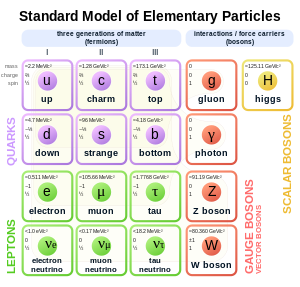Elementary particle
Appearance

In particle physics, an elementary particle or fundamental particle is a particle whose substructure (domain of the bigger structure which shares the similar characteristics of the domain) is unknown, thus it is unknown whether it is composed of other particles.
| This science article is a stub. You can help out with Wikiquote by expanding it! |
Quotes
[edit]- One of the most natural questions when one looks at the mass of uncorrelated data on elementary particle interactions is whether a systematic pattern is emerging from this complexity. The penetration of controlled laboratory experiments into the multi-Bev energy region can only make such a question more acute.
- R. E. Behrends, J. Dreitlein, C.Fronsdal and W. Lee, "Simple groups and strong interaction symmetries", Revs. Modern Phys. (1962)
- It's a remarkable fact that matter at the subatomic level consists of tiny chunks, with vast empty spaces in between. Even more remarkable, these tiny chunks come in a small number of different types (electrons, protons, neutrons, pi mesons, neutrinos, and so on), which are then replicated in astronomical quantities to make all the "stuff" around us. And these replicas are absolutely perfect copies—not just "pretty similar," like two Fords coming off the same assembly line, but utterly indistinguishable.
- David Griffiths, Introduction to Elementary Particles. John Wiley & Sons. 26 September 2008. p. 1. ISBN 978-3-527-61847-7.
- Even with our best understanding in traditional physics, there are dozens of different things that we can call elementary particles. The idea of string theory is to get all the different elementary particles — muons, neutrinos, electrons, up quarks, gluons, and so on — as different states of vibration of one basic string.
- Edward Witten, "ICTP-SAIFR Strings 2021 - June 27 - Ask a String Theorist". ICTP-SAIFR Strings 2021, YouTube. (quote at 43:57 of 1:34:25)

